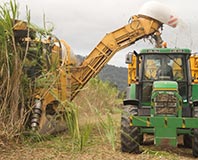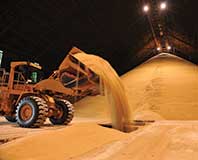Read the latest information on
Foot-and-mouth disease

Photo courtesy of Bernard Milford, Halcyon Photography
For the first time, sugarcane growers have a manual dedicated to their biosecurity needs.
Sharyn Taylor, National Manager Broadacre Cropping at Plant Health Australia, said that the manual includes advice in line with the Farm Biosecurity essentials.
“The essentials have been tailored to address situations that cane growers may relate to,” said Sharyn.
In terms of farm inputs, for example, the sugar industry relies on growers planting approved disease resistant varieties of cane. This minimises the risk of epidemics in regions where diseases are established. Every year the list is reviewed and new varieties are added.
An epidemic could have serious long-term economic consequences for a district. In the event of a disease outbreak the industry cannot quickly replace susceptible varieties with resistant varieties.
“Most cane growers would be familiar with this,” said Sharyn.
Other aspects of biosecurity included in the manual would be less familiar to a cane grower.
“Even though controlling and limiting access to production areas is a simple way to minimise biosecurity risks, fencing is not commonly used on cane farms,” said Sharyn.
Fencing minimises potential entry points for new pests and weeds and makes it easier for you to monitor and control visits.
“In this case, biosecurity is about trying to assess where strong and weak points are and addressing them at the farm level,” said Sharyn.
Advice in the manual can also help growers to meet what’s called the ‘general biosecurity obligation’.
“Under new legislation in Queensland, and soon in NSW, everyone has a responsibility for the biosecurity risks under their control,” advised Sharyn.
The general biosecurity obligation means that everyone must take all reasonable steps to ensure that they do not spread a pest, disease, weed seeds or contaminant, and that everyone has a responsibility to report unusual events that might be related to biosecurity.
“You aren’t expected to know everything about all biosecurity risks. But you are expected to know about risks associated with your work or day-to-day activities.”
 For example, cane growers are expected to be aware of the pests and diseases that affect their crops and to manage them appropriately, including reporting unusual symptoms or pests.
For example, cane growers are expected to be aware of the pests and diseases that affect their crops and to manage them appropriately, including reporting unusual symptoms or pests.
In addition to the usual information about exotic and established sugarcane pests to keep an eye on, the manual also includes descriptions of regionalised weeds, how they spread and ways in which to prevent them from entering your property.
Reviewed by experts from Sugar Research Australia, Canegrowers and field officers who work with farmers on Smartcane BMP, the manual complements the biosecurity module of Smartcane that is used on 170 accredited cane farms.
“Although not a formal part of Smartcane BMP modules, growers can use the manual to bolster the biosecurity measures they may already use.”
Hard copies of the manual have been printed and will be distributed to growers by Sugar Research Australia with their CaneConnection magazine in March 2017.
Electronic copies are available from the new Sugarcane section of the Farm Biosecurity site. The sugarcane toolkit in the Farm Biosecurity profiler includes the manual, a biosecurity checklist, a pest surveillance record sheet, visitor register and a template for a biosecurity sign.